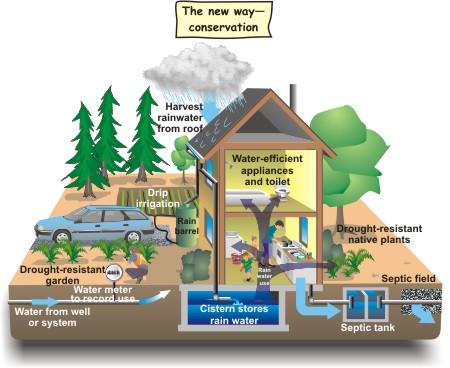 Additional water resources will be
needed to meet the growing population and economy of the SCAG
region. Sufficient water supplies are needed to meet these future
water demands. In addition water quality and watershed management
needs to be addressed.
Additional water resources will be
needed to meet the growing population and economy of the SCAG
region. Sufficient water supplies are needed to meet these future
water demands. In addition water quality and watershed management
needs to be addressed.
Water supplies in the SCAG region come from a blend of local and
imported sources. Water conservation, or efficiency, involves
technological and behavioral changes that lower the demand for
water.
Past Events
Southern California Stormwater Meeting
Friday, June 13, 2014
In the midst of a historic drought and challenging regulatory
orders that Southern California reduce the effects of stormwater
pollution from the built environment, leaders agree that now is
the time to act. That means designing, approving, and finding
ways to pay for the stormwater capture projects we need that will
also infiltrate water into our local groundwater basins and
increase our water supply reliability in future years. A meeting
was held on Friday, June 13, 2014, to discuss and develop
practical strategies for overcoming the biggest challenges to
stormwater capture. There were three panels that discussed
various topics pertaining to stormwater. Watch the videos:
SCAG’S WATER PLANNING PROGRAM
The Water Planning Program was concerned with the comprehensive
management of water resources in the urban watersheds of the SCAG
region. These resources include the use and reuse of imported and
local water, the discharge of highly-treated wastewater, the
conservation of water supplies, the reclamation of water supplies
and the management of stormwater and urban runoff. Of special
importance in this urban setting is the collaboration of local
agencies to jointly plan and implement pollution control measures
that protect the environment, are cost-effective and sustainable.
The Program recognizes a connection between water supplies and
water quality and between land use, water quality and water
supplies:
- As water quality impairments lead to more extensive pollution
controls in the region’s watersheds, higher levels of water
treatment will result in new, purer water for reuse.
- With the increasing use of more compact land development
designs, more extensive natural areas will create new
opportunities for pollutant removal from storm flows and also
encourage the conservation of stormwater by providing areas for
infiltration.
The Program developed a series of reports for the Caltrans
Environmental Analysis Section that relate stormwater management
issues to the planning and implementation of the proposed major
projects in the 2004 Regional Transportation Plan.
In addition, SCAG’s Regional Comprehensive Plan (RCP) was updated
in 2008. The Water Chapter of the RCP focused on themes such as
meeting the region’s water supply needs, the relationship between
land uses and water quality, the important relationship between
regional water reliability and water storage facilities, the
continuing need for more water conservation, and the connection
between agency collaboration, best management practices and
cost-effective pollution control measures.
2008 SCAG Regional Comprehensive Plan Water Chapter
GROUNDWATER
Groundwater accounts for most of the region’s local supply of
fresh water. Growing water demand has led to over-pumping of
these natural groundwater basins.
SURFACE STORAGE
Surface storage involves the use of reservoirs to collect water
for later release and use. It has historically played an
important role because it can store water in wet times and
release it during dry times. However, it is very difficult to
build new storage capacity because of environmental concerns,
stream flow and loss of habitat.
RECYCLING
Recycling involves the collection of wastewater followed by
treatment to make the effluent suitable for non-potable uses.
Reuse can include irrigation, commercial and industrial processes
and groundwater recharge. While many potential uses exist for
recycled water, a number of health and cost barriers limit the
use of recycling.
Case Study: Orange County Water
District’s Groundwater Replenishment Program
WATER CONSERVATION
Conservation is intended to lower the demand for water through
technological or behavioral changes. One mechanism is through
groundwater banking, where one water agency “holds” water
conserved by a different agency for future use, such as during a
period of drought. Other techniques include water saving devices
(e.g. low flow toilets) and practices (e.g. restrictions on yard
watering).
WASTEWATER
Most of the SCAG region is serviced by a number of large publicly
owned wastewater treatment facilities, such as the City of Los
Angeles’ Hyperion Facility. Future population and
economic growth will require new or expanded wastewater
facilities.
Case Study: Hyperion
Wastewater Treatment Plant
WATER QUALITY
The general quality of surface water and groundwater in the SCAG
region tends to be degraded as a result of land uses and water
management practices. Agricultural lands use fertilizers and
pesticides that degrade water quality. Septic systems degrade
groundwater. The urbanization of the region has led to increased
use of impervious surfaces and the concentration of pollutants
that infiltrate the ground or are carried out to the ocean.
IMPORTED SOURCES
The SCAG region has historically depended on imported water to
supplement local water supplies. Water is conveyed to the SCAG
region by three major water projects:
The water from these projects is fully allocated and cannot
accommodate future growth projections in the SCAG region.
WATER DEMAND
Water demand in the SCAG region can generally be divided between
water used for urban and agricultural uses and water necessary
for maintaining existing ecosystems. In the SCAG region
approximately three-quarters of the potable water is provided
from imported sources. Through advances in water conservation,
recycling and infrastructure improvements, an additional 3.5
million people have been accommodated with the same amount of
imported water.
ADDITIONAL RESOURCES
California Department of Water
Resources
California State Water
Resources Control Board
US EPA Watershed Approach Framework
US Army Corps of
Engineers
US Bureau of
Reclamation
Santa Ana Watershed Project
Authority
Metropolitan Water District of
Southern California
Association of Groundwater
Agencies
California Stormwater Quality
Association

